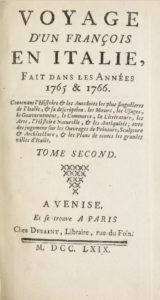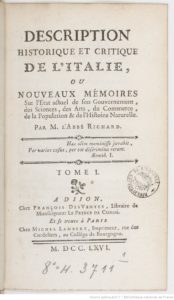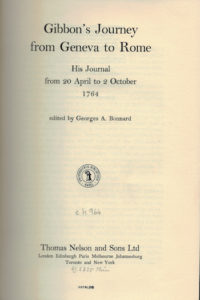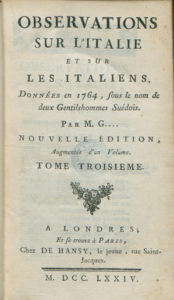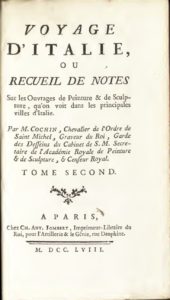
Dupaty’s travel account is one of the later sources gathered in this blog. It was written in the form of letters, a common style used by many writers, such as Charles de Brosses and John Boyle; it therefore includes more personal remarks. Dupaty’s observations and experiences from several major cities (including Genoa, Florence, Rome and Naples) form the narrative, but his principal interest lies in art and architecture. The description of the Camposanto reveals that Dupaty quite liked the cemetery for its atmosphere, the architecture, and for its sarcophagi. Even the legend of the holy earth and its effect (the earth decomposes bodies in one hour, he says), which seems to have been forgotten around the late eighteenth century, is given mention. Wall paintings at the Camposanto, however, are not discussed at all; his silence is all the more striking when compared to the group of letters written from Florence: the statues and paintings Dupaty saw in the Uffizi gallery are described at length and with much excitement. / DJ
Dupaty, Lettres d'Italie (excerpt)
Source: Charles-Marguerite-Jean-Baptiste Mercier Dupaty, Lettres sur l’Italie en 1785, 2 vols. (Paris: De Senne, 1788), 1:109-110.
Translation: Travels Through Italy: In a Series of Letters Written in the Year 1785, translated from the French by an English Gentleman (Dublin: M. Mills, 1789), 68-69.
Transcription
Lettre 24. A Pise
“Mais on est saisi, on est frappé, en entrant dans le campo santo, autrefois le cimetière des Pisans; superbe et immense cloître, rempli des tombes et de mausolées de marbre, dont plusieurs sont admirables. Un de ces mausolées a été érigé à Algarotti, par le roi de Prusse. Ovidii aemulo, Newtonii Discipulo, Fredericus Magnus. Les noms d’Ovide, d’Algarotti, de Newton, de Frédéric, sur un tombeau!
Le milieu de ce cloître est un jardin, dont le sol est de la terre sainte, que les Pisans apportèrent, du temps des croisades, pour y enterrer leurs morts. Cette terre a, dit-on, une propriété remarquable: elle dévore un cadavre en une heure. Mon imagination retournera plus d’une fois au campo santo. Tous ces marbres, toutes ces épitaphes, ce long cloître, ce silence, cette solitude, cette terre, ces grands noms, ces siècles; que le cœur est ému et pressé parmi tout cela!”
Translation
Letter 24. To Pisa
But nothing can surpass the astonishment and admiration with which you must be struck on entering the Campo Santo, the ancient burying-ground of the Pisans; a superb and immense cloister, filled with marble tombs and mausolea, many of which are admirable. One of these mausolea was erected by the king of Prussia to the memory of Algarotti. Ovidii aemulo, Newtonii Discipulo, Fredericus Magnus. The names of Ovid, Algarotti, Newton and Frederic on one tomb!
The middle of the cloister is a garden, the ground of which consists of earth brought from the Holy Land by the Pisans, at the time of the crusades, to inter their dead in. This earth, they pretend, has a remarkable property: it destroys the body in an hour. My imagination will return more than once to the Campo Santo. All those marbles, those epitaphs, that length of cloister, that silence, that solitude, that ground, those great names, those ages past: how is the heart moved and agitated amidst all these!

